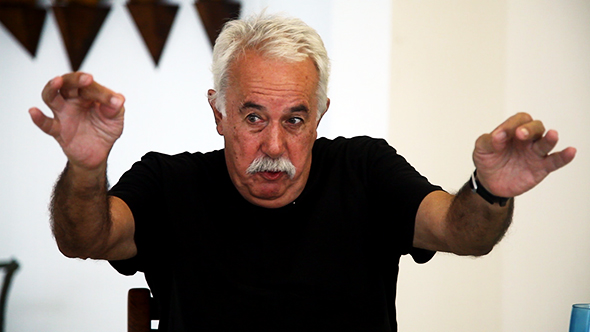
Interview Part 1 (Shroud) with the artist Carlos Vergara as he talks about his monotype printing process and the importance of chance, 2014.
An Artist-Traveler
Interview: Carlos Vergara, artist
To discover the unknown is not a prerogative of Sinbad, or Eric the Red, or of Copernicus. Each and every man is a discoverer. He begins by discovering bitterness, saltiness, concavity, smoothness, harshness, the seven colors of the rainbow and the twenty-some letters of the alphabet; he goes on to visages, maps, animals and stars. He ends with doubt or with faith, and the almost total certainty of his ignorance.”
Jorge Borges, Atlas1
To discover the unknown, as Borges says, is not the unique prerogative of the traveler, but a state of being and of positioning oneself in the world – a position of curiosity, engagement and a permanent sense of being a learner. In this interview, the artist Carlos Vergara reflects on his artistic practice via three recent projects, Shroud, Freedom, and the Baldia Pharmacy. Here, travel – at its most worldly and local, real and symbolic – assumes a vocational reverence to the singularities that inhabit each place. As an artist-traveler, Vergara sees his role as that of a supporting actor who, in communion with each place, fuses an aesthetic-ethical impulse that recovers multiple narratives and voices rendering their invisible vestiges visible. Using different formats and media, the artist plays games of “dice and darts” guided by a palpable intuition in the act (ritual) of deepening ways of seeing, exposing social realities and awakening complicity in others.2
This interview lasts approximately 20 minutes and is presented here in three parts:
1. Shroud. Explores the practice of the artist-traveler through his monotypes using handkerchiefs recently presented in his exhibition at the Museum of Contemporary Art (MAC) of Niterói (December 13, 2013 to March 9, 2014).
2. Freedom. Reflects on the Freedom installation, inspired by the process of accompanying and documenting the implosion in 2010 of Frei Caneca, the historic Rio de Janeiro prison founded during colonial rule in the nineteenth century.
3. Baldia Pharmacy of Boa Viagem. Inaugurated during Vergara’s recent exhibition at the MAC, Niteroi, the Baldia Pharmacy of Boa Viagem is a collective action surrounding the museum and the community of Morro do Palácio integrating art and health via the study and use of medicinal plants.
Vergara was born in Santa Maria, Rio Grande do Sul in 1941. In 1965, the artist participated in the exhibition Opinion 65, at the Modern Art Museum of Rio de Janeiro, a landmark in the history of Brazilian art, highlighting the critical posture of a new generation in relation to the social and political realities of the time. This exhibition was key to the launching of the Brazilian New Figuration movement that Vergara founded with Antonio Dias, Rubens Gerchman and Roberto Magalhães, among other artists. In the 70s, his work explored the complex transformations of a polarized decade of repression and ethical and aesthetic experimentation, resulting in several series of photographs and installations. From the 1980s onwards, Vergara’s work directly responds to the crisis in painting, and it is in this period that he begins his first monotypes and practice of travel as a means to discover the singularity of place, engaging with the profound material and pigments of Brazilian memory. During this time the artist-traveler Carlos Vergara initiated a unique path of experimentation, deploying various media and always seeking to expand the possibilities of the meaning of painting and art in the contemporary world. Vergara has traveled worldwide and to diverse regions throughout Brazil from the jungle-like Pantanal (Mato Grosso), the steps of the Pelourinho (Bahia), and Minas Gerais to the Missions of San Miguel (Rio Grande do Sul) where he not only discovered Brazilian roots but also found a means of responding to the crisis of late twentieth-century painting, connecting an existential and spiritual archeology of art and the artist to the contemporary.
In his career, Vergara has been indefatigable, participating to date in more than 180 solo and group exhibitions. Ethically generous and experimental, the artist also constantly provokes an exploration of the collective – what it means and how to live together.
For more information about the artist: http://www.carlosvergara.art.br/en/
_
1 Jorge Luis Borges in collaboration with Maria Kodama. Atlas. New York: E. P Dutton, 1985, p. 8
2 Interview Carlos Vergara, February 2014.



